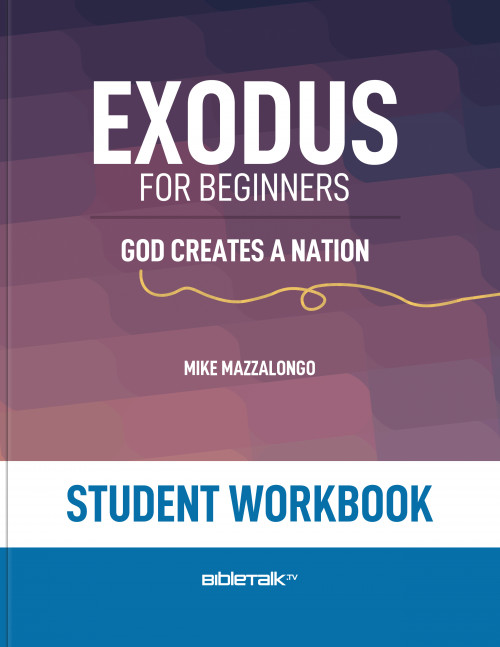The Covenant Between God and Israel
God Gives Moses the Plans for the Tabernacle - Part 2
So far in our study of the Tabernacle described in Exodus 25-31, we have briefly looked at the plans for the following parts of the Tabernacle complex, which includes the tent, courtyard, fencing, and holy objects as follows:
- The Ark of the Covenant – Holy of Holies
- The Table of Showbread – Holy Place
- The Golden Lampstand – Holy Place
- Curtains, boards, sockets, veil, and screens – Holy Place
- The Bronze Altar for burnt offerings – Courtyard
- The Court of the Tabernacle – Courtyard
- The oil for the Golden Lampstand – Courtyard
In this lesson I want to complete the description of the remaining elements and other details given to Moses by God concerning the Tabernacle.
I. The Garments of the Priests – Exodus 28:1-43
A. The Priests Identified – Exodus 28:1-5
1"Then bring near to yourself Aaron your brother, and his sons with him, from among the sons of Israel, to minister as priest to Me–Aaron, Nadab and Abihu, Eleazar and Ithamar, Aaron's sons. 2You shall make holy garments for Aaron your brother, for glory and for beauty. 3You shall speak to all the skillful persons whom I have endowed with the spirit of wisdom, that they make Aaron's garments to consecrate him, that he may minister as priest to Me. 4These are the garments which they shall make: a breastpiece and an ephod and a robe and a tunic of checkered work, a turban and a sash, and they shall make holy garments for Aaron your brother and his sons, that he may minister as priest to Me. 5They shall take the gold and the blue and the purple and the scarlet material and the fine linen.
- Exodus 28:1-5
At this point, God pauses in His description and plans for the Tabernacle itself and begins giving instructions to Moses concerning the ones who would actually be serving in the religious duties at the Tabernacle. Before this time others performed the priestly functions – mainly offering animal sacrifices.
These things were usually carried out by family heads (i.e. Abraham built altars and offered sacrifices – Genesis 12:8; 13; 18). There is also the example of Jacob offering (Genesis 35:7) sacrifice on an altar he built to commemorate God appearing to him at Bethel. The practice had long been established, but until now there was no uniform sacrificial system in place, nor was there any priestly class appointed by God.
Since the nature and practice of the newly formed nation's religion would involve a systematic and orderly practice of animals, food, wine, and incense being sacrificed, mainly by fire – there needed to be both a place (the Tabernacle) and people (the priests and Levites) to carry out this work and maintain its location.
Thus far, God has instructed Moses in the building and assembling of the tabernacle but here, in chapter 28, the Lord specifies who would serve as priests (Aaron and his four sons) and then describes the garments these would wear in the performance of their duties.
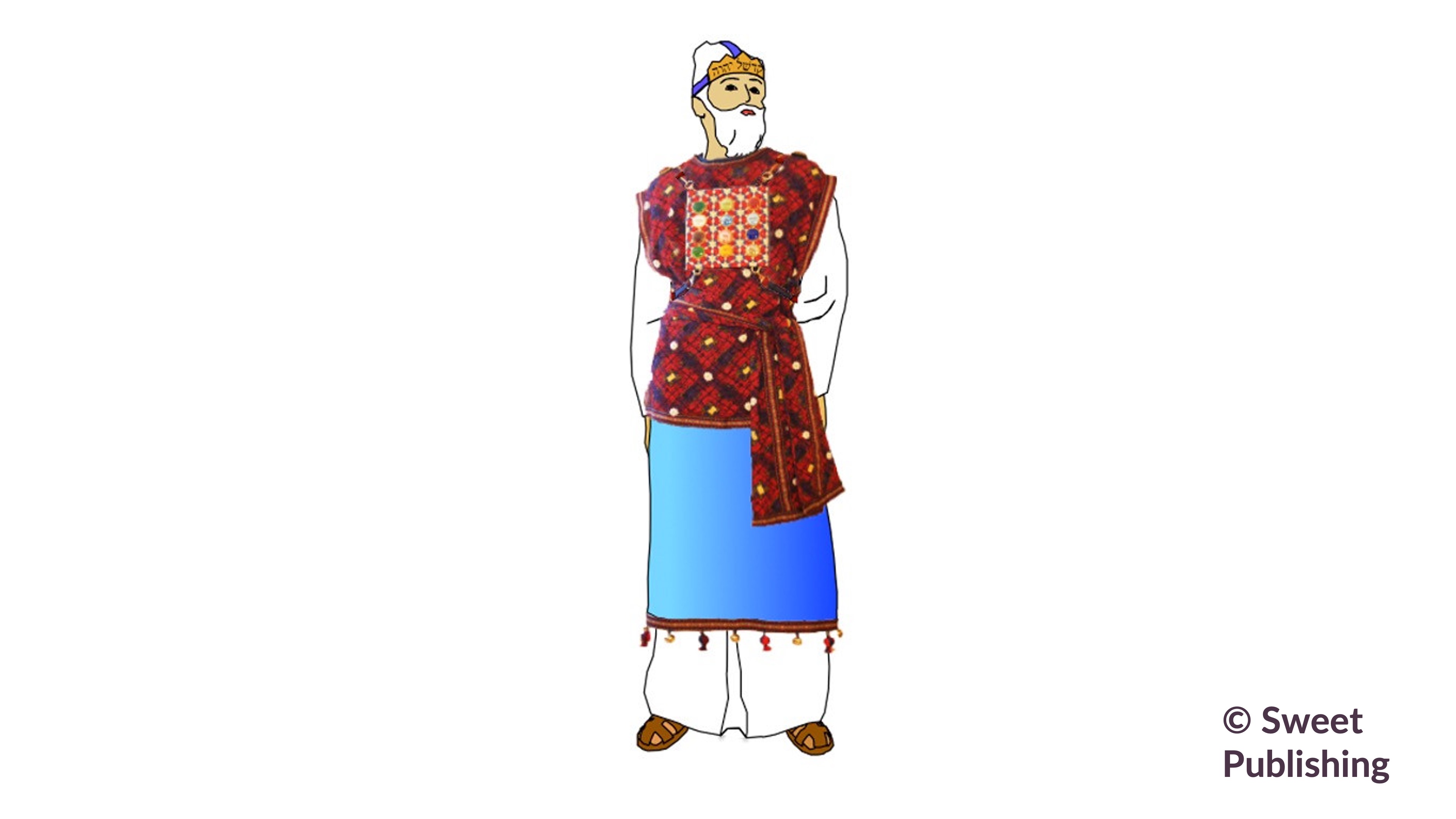
God first describes what Aaron, who would serve as High Priest, would wear while serving in this role:
- An Ephod with the onyx stones – Exodus 28:6-14
- The Breastpiece which carried the Urim and Thummim – Exodus 28:15-30
- The Robe – Exodus 28:31-35
- The Turban, gold, plate, tunic, and sash – Exodus 28:26-39
These items were only worn by the High Priest. The chapter ends by describing the garments worn by both the High Priest, as well as all others who served as priests.
- Tunics, Exodus 28:40-43 sashes, caps, and linen breeches (pants that were secured around the waist and went down to below the knees or to the ankles).
With His selection of Aaron, God consecrated only one family to serve as priests. We learn that not long after they were confirmed as priests, two of the sons (Nadab and Abihu) were put to death by God for having burned "strange" or unauthorized incense on the altar. The other two sons, however, served faithfully.
- Ithhamar is mentioned later (Exodus 38:21) in connection with the actual building of the tabernacle (Eli the priest is his descendant).
- Eleazar became the High Priest after Aaron died (Numbers 20:24-25). Zadok is his descendant.
Note that while the tribe of Levi became the tribe from which the priests came, not all Levites were priests. Only those from the family of Aaron could qualify to serve as priests and the High Priest was chosen from that family. Later on, the men of the Levitical tribe distinguished themselves at a critical moment in their service to God (Exodus 32:26-28) and as a reward were set aside as a priestly tribe and commissioned to be the exclusive helpers to the priests (similar to deacons today). As a result, all the priests were Levites, but had to be descendants from Aaron's family lineage and all those who served at the Tabernacle and later the Temple were from the tribe of Levi, but from the different families. Teachers (Rabbis, Pharisees) were from various tribes since they were not involved in the sacrificial system or rituals.
B. Construction of Priests and Offerings – Exodus 29:1-43
1. The Priestly Garments – Exodus 29:1-9
1"Now this is what you shall do to them to consecrate them to minister as priests to Me: take one young bull and two rams without blemish, 2and unleavened bread and unleavened cakes mixed with oil, and unleavened wafers spread with oil; you shall make them of fine wheat flour. 3You shall put them in one basket and present them in the basket along with the bull and the two rams. 4Then you shall bring Aaron and his sons to the doorway of the tent of meeting and wash them with water. 5You shall take the garments and put on Aaron the tunic and the robe of the ephod and the ephod and the breastpiece and gird him with the skillfully woven band of the ephod; 6and you shall set the turban on his head and put the holy crown on the turban. 7Then you shall take the anointing oil and pour it on his head and anoint him. 8You shall bring his sons and put tunics on them. 9You shall gird them with sashes, Aaron and his sons, and bind caps on them, and they shall have the priesthood by a perpetual statute. So you shall ordain Aaron and his sons.
- Exodus 29:1-9
Once Aaron and his sons are chosen to serve as priests, God instructs Moses in the ritual to perform in order to "sanctify" or set apart these individuals for the particular work or service God has intended for them. In this case it was to confirm that Aaron, his sons, and their descendants would always serve as priests to the nation of Israel. In this passage we see that the high priest wears the tunic, robe, the ephod, with the breast piece attached, and finally the turban with the gold plate with the words, "Holy to the Lord" engraved on it. This order of dress was to be repeated by Aaron and followed by every High Priest that came after him.
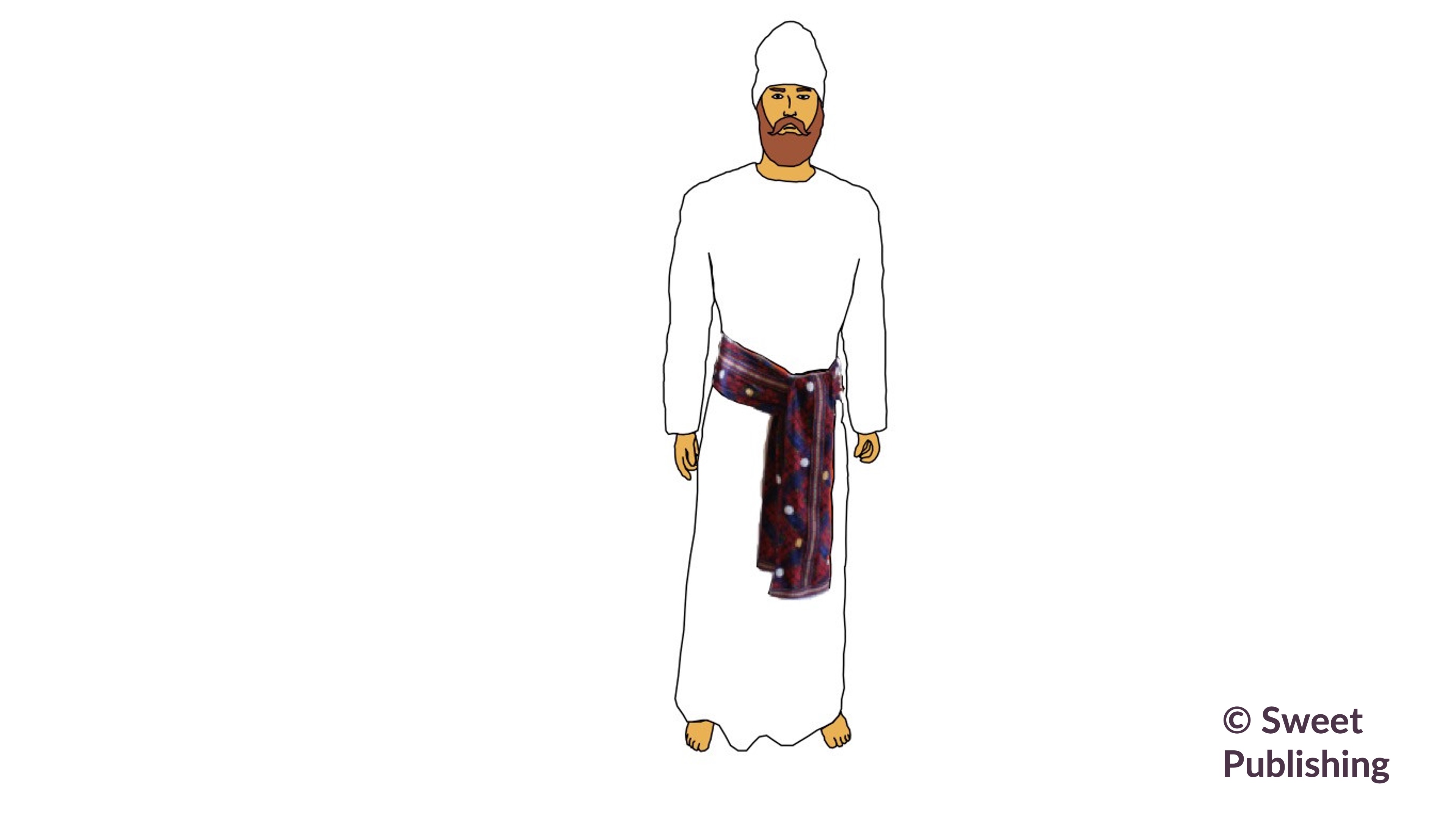
Note also that Aaron's sons, as well as every priest who would come after them wore much simpler garb.
- Tunics
- Sashes which were used like belts to pull their clothing tightly on to their bodies
- Caps on their heads
Serving "perpetually" as priests meant that so long as the Law remained in force, no one from any tribe other than Levi, and no one from any family other than Aaron's would be allowed to serve as priest or High Priest. Perpetual (in this context does not mean forever, but rather, as long as the conditions permit).
2. The Consecration Ceremony – Exodus 29:10-37
The ordination followed this procedure:
A. The presentation of the offerings that accompanied the ordination. 1 Young bull; 2 rams; unleavened bread and cake and unleavened wafers in a basket – Exodus 29:1-3. These were presented to the Lord represented by Moses, and this done when the Tabernacle was completed.
B. Wash the priests with water – most likely in the laver situated in the courtyard for that purpose – Exodus 29:4
C. Moses was to dress Aaron with the High Priest's special garments explained earlier – Exodus 29:5-6
D. Aaron was to be anointed with oil poured on his head. A ritual used to denote that a person was being chosen or set apart for a special role or task (i.e. prophet, king, priest) – Exodus 29:7
E. Aaron's sons are dressed for their service – Exodus 29:8-9
F. Offering and consumption of the sacrifices which were sacrificed in the following order:
1) The bull as a Sin Offering – Exodus 29:10-14
This offering was done to atone for or take away the sins of the priests being ordained. This established the core idea that sin causes death and a life must be offered to remove sin to atone for or redeem for it. Before Aaron would offer sacrifices to atone for the sins of the people, a sacrifice had to be made to atone for himself since even if he was the High Priest – he was still a sinner.
2) Offering of the first ram – Exodus 29:15-18
As was done with the bull, Aaron and his sons laid hands on the animal, it was killed, and blood was sprinkled around the altar. Then the animal was cut up and washed and then completely offered on the altar. Nothing was kept of the animal, so the sacrifice was to signify thanksgiving and gratitude to God.
3) Offering of the second ram – Exodus 29:19-34
This ram is called the "Ram of Ordination" because its blood was used not only to make atonement, but primarily to ordain Aaron and his sons. This was signified by first dabbing the blood of this ram on the lobe of the priest's right ear, thumb, and big toe. This signified the dedication of the entire person to God. After this was done, the ceremony continued by sprinkling the animal's blood around the altar and then part of the animal along with part of the unleavened bread were burnt on the altar as a burnt offering. The remaining pieces of this second ram and the left-over bread were to be eaten by the priests at the door of the Tabernacle. Whatever was left would be burned.
4) This offering of sacrifices and consumption of food was to be repeated each day for seven days, after which, not only the priests were ordained for ministry in the tabernacle, but the altar where the sacrifices were made was consecrated – Exodus 29:35.
3. Types of Sacrifice
We often read in the Old Testament that certain types of sacrifices were made or required, however no explanations are given, so here are a few definitions to help us sort these out.
A. The Sin Offering or Guilt Offering (Leviticus 4-6)
- Sin offering to atone for sins against God.
- Guilt offering addressed sins against others, also included paying for damages.
- The meat belonged to the priests for food.
B. Burnt Offering (Leviticus 1)
- This sacrifice represented complete surrender to God.
- An unblemished male animal bears the worshipper's sins and dies in his place.
- The animal was completely burned up and there was no meat left for eating.
C. The Grain or Meal Offering (Leviticus 2)
- These were given to God in thankfulness. Fine flour, unleavened cakes or roasted grain were used.
- The priest would throw a symbolic handful at the altar and keep the rest for personal use.
D. Fellowship or Peace Offering (Leviticus 2; 7:11-21)
- This offering symbolized fellowship and peace with God through shed blood (sacrifice).
- After some meat was ceremonially waved and given to the priests, worshippers and their guests could share the feast as a meal taken with God.
- The "thank offering" and the "vow offering" and the "freewill offering" were all different types of peace offerings.
E. Wave Offering and Heave Offering
- These refer to a type of ritual action where the sacrifice was first "waved" in some manner before being placed on the altar.
- The movement of waving the sacrifice towards the altar and then away from it, signified presenting a gift to God and receiving it back in some manner.
- A Heave Offering was a sacrifice completely dedicated to God.
4. Daily Offerings – Exodus 29:38-42
- It is in this passage that God instructs Moses that each morning and night a one-year-old lamb is to be offered as burnt sacrifice (completely burned up with no leftovers for food).
- They were also to add a portion of fine flour, oil, and wine so that the total sacrifice would represent parts of a complete meal.
- This instruction was carried out even to the time of Jesus.
5. The Results of This Consecration of the Priests and the Tabernacle – Exodus 29:43-46
43I will meet there with the sons of Israel, and it shall be consecrated by My glory. 44I will consecrate the tent of meeting and the altar; I will also consecrate Aaron and his sons to minister as priests to Me. 45I will dwell among the sons of Israel and will be their God. 46They shall know that I am the Lord their God who brought them out of the land of Egypt, that I might dwell among them; I am the Lord their God.
- Exodus 29:43-46
The purpose for the complex and demanding rituals was to keep Israel mindful that this was no ordinary place, but the place where God met with the ones who served as their mediator with God, the priests. This place and what God had given them through their anointed priesthood (sacrificial system) assured the people that He would be with them in the future.
II. The Altar of Incense – Exodus 30:1-38
Chapter 30 concludes the Lord's instructions to Moses concerning the building of the Tabernacle complex and objects found in it, the garments worn by the priests, their consecration, and some of their duties. Four things remain:
1. The Altar of Incense – Exodus 30:1-10
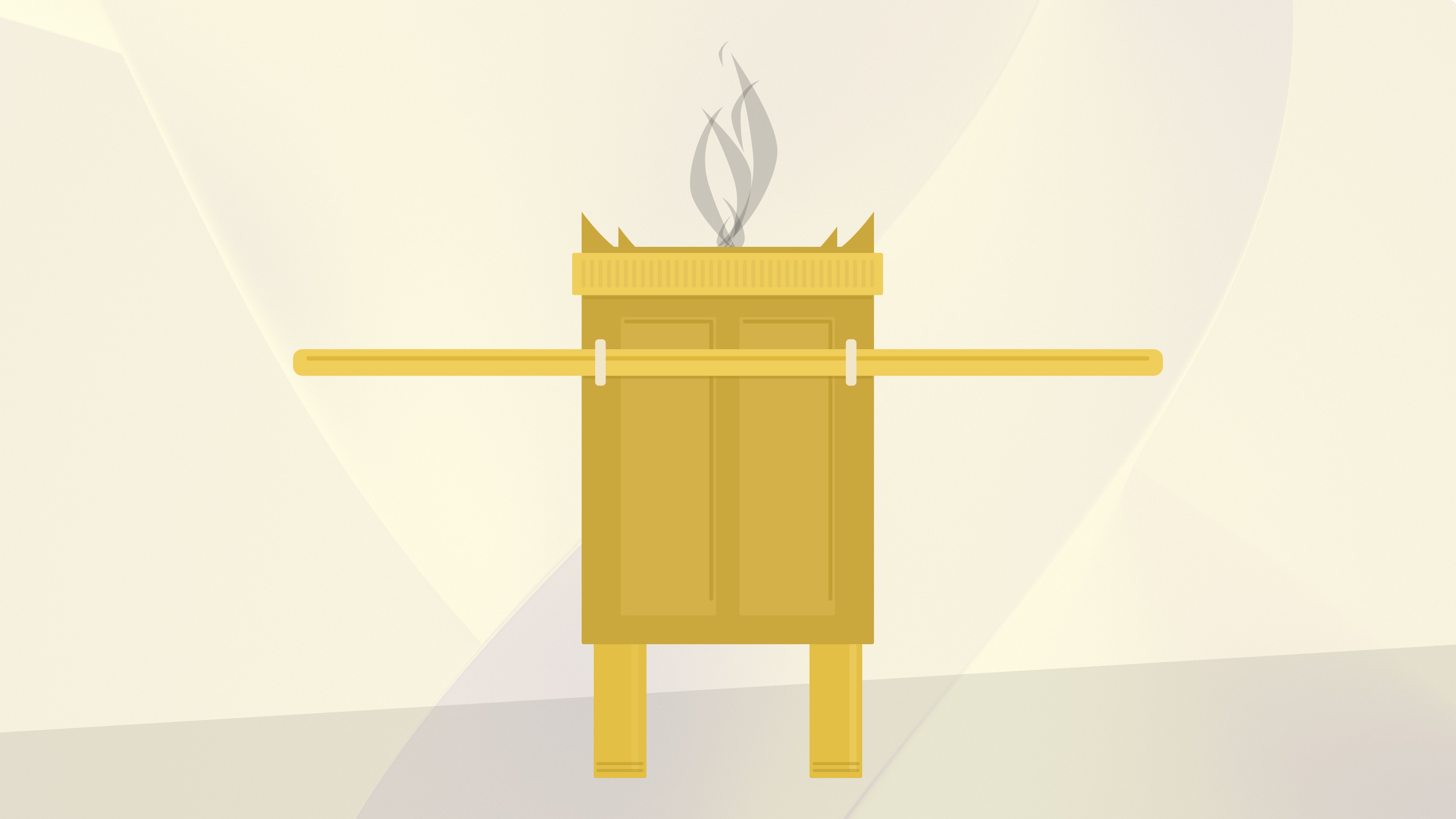
An 18" square table, 3' high with horns on each corner and rings with poles for carrying and a molding around its top – made of acacia wood and all covered in gold. It was placed in front of the veil that led into the Holy of Holies where the Ark was located.
Each morning and evening a priest was to burn fine incense (made especially for this purpose) on this altar, so that there was always a fragrant aroma there 24/7. No other "strange" or unauthorized incense was to be used for this twice daily ritual. (This is why Nadab and Abihu, Aaron's sons, were killed – they offered unauthorized or "strange fire" on the altar of incense).
No burnt meal or drink offerings were to be made on this altar except on the once yearly Day of Atonement when the High Priest would sprinkle the blood of the sin atonement (which was sacrificed on the altar in the courtyard) on the horns of the altar of incense, before going into the Holy of Holies to do the same on the Ark of the Covenant. The cloud produced by burning the incense would represent the presence of God with His people, located in the Holy of Holies.
2. Required Tax – Exodus 30:11-16
The emphasis here is how the Tabernacle and its work would be funded – ½ shekel paid by each adult 20 years and over (according to census records). This tax was seen as a form of personal dedication to the Lord for those who were not priests. Just as the priests were purified and the objects in the Tabernacle were consecrated, the people were devoted to the Lord by the offering of this tax to sustain the priests and the Tabernacle.
3. The Bronze Laver – Exodus 30:17-21
17The Lord spoke to Moses, saying, 18"You shall also make a laver of bronze, with its base of bronze, for washing; and you shall put it between the tent of meeting and the altar, and you shall put water in it. 19Aaron and his sons shall wash their hands and their feet from it; 20when they enter the tent of meeting, they shall wash with water, so that they will not die; or when they approach the altar to minister, by offering up in smoke a fire sacrifice to the Lord. 21So they shall wash their hands and their feet, so that they will not die; and it shall be a perpetual statute for them, for Aaron and his descendants throughout their generations."
- Exodus 30:17-21
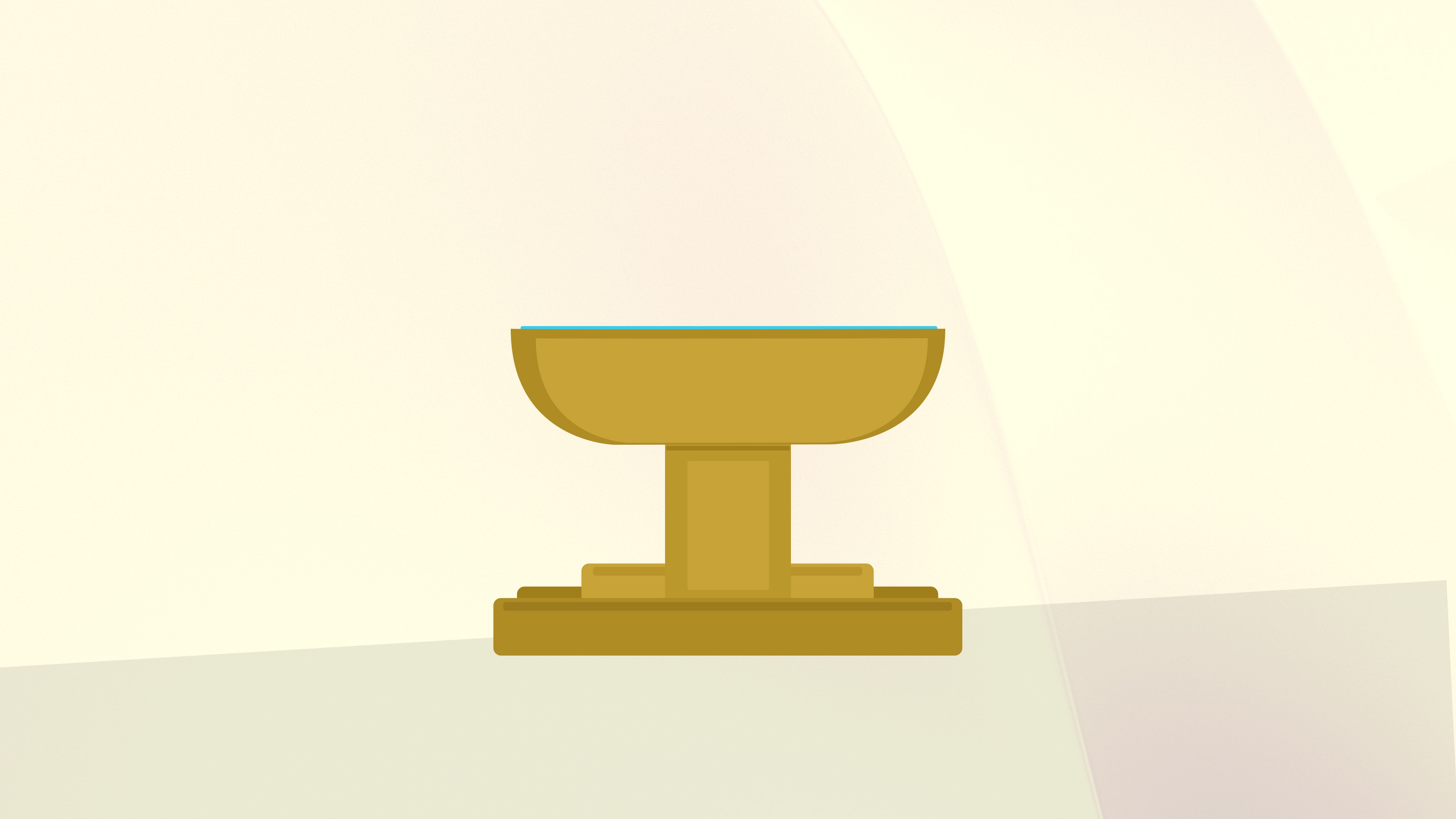
The laver was to be used for ritual washing of the priests' hands and feet every time they were to enter the Holy Place in order to minister there or entered the Tabernacle courtyard to offer sacrifice on the bronze altar. God wanted the Tabernacle to be considered a holy place because of His presence there. This was reinforced by the command that to neglect to wash would result in death.
4. The Anointing Oil – Exodus 30:22-33
God provided instructions for the production and use of the special type of anointing oil which was only to be used by the priests in connection with their ministry at the Tabernacle. God deemed it to be holy and whatever it anointed became holy (separate unto God and for His purpose (vs. 29). This is why personal use was forbidden.
5. The Incense – Exodus 30:34-38
The instructions for making and using the incense were similar to the ones for the anointing oil.
- A detailed recipe given
- The required ingredients were rare and expensive
- The incense itself was to be regarded as holy
- No one was to produce or use it for personal use
- Breaking this rule was punishable by death
This incense was primarily used on the altar of incense located in front of the veil that hid the Holy of Holies from view and separated it from the Holy Place.
III. Summary and Final Instructions – Exodus 31:1-18
Once the commandments and the plans for the Tabernacle are given to Moses, God also appoints and empowers with wisdom and ability two craftsmen who will direct the construction of this Tabernacle.
Bezalel and Oholiab
Next, God reviews briefly all of the items He has previously described to Moses in chapters 25-30. He then reviews, once again, the importance of keeping the Sabbath day holy, otherwise all the commands concerning the Tabernacle and the spiritual exercises performed there by the priests on behalf of the people would be of no use. Most of the instructions given to Moses had to do with the building of the Tabernacle, its furnishings, the garments for the priests, and details concerning their service before God on behalf of the people.
The command to keep the Sabbath, however, did not require the use of the Tabernacle, or the service of a priest or a sacrifice of some sort – it was strictly something between the individual and God – and the Lord reinforces it one last time before Moses leaves the mountain, in order to bring the plans for the Tabernacle – the place where God will meet with the Israelites, the people chosen to be in the covenant with God.
Lesson
I think that there is really only one practical lesson that stands out from this section filled with commands and regulations:
Christians need to understand and accept the fact that there is a real difference between what is holy and what is unholy.
God went to great lengths to teach His people this lesson: The food laws (clean and unclean); the regulations concerning their worship (Holy things and people were special and treated differently); certain days were ordinary, but others were holy (Sabbath, Day of Atonement). All of this pointed back to God, who was holy and who wanted His people to be holy.
These guidelines helped the people develop the virtue of "piety" – a pious person has and shows respect for things, actions, and people that are holy. A pious person has respect for God, as well as the people, and the things of God.
Today we're seeing in the world the democratization of everything- corporate presidents dress the same as the intern in the mail room. We treat presidents and those who have achieved great things, because of skill or courage, the same way as we treat the guy who has never held down a job – we pay no respect to anyone.
That's fine for society where everyone is human and no one is perfect. But it can't work like that in the church because here God is among us!
- His presence – through the Holy Spirit within each person
- His Word – through the Bible
- His Practices – baptism and communion
- His Command – that we love each other
- His Body – the church (we are the people of God today!)
- His Ministries – preachers, teachers, elders, and deacons (anointed servants)
- His People – the Saints in Christ
His presence demands piety and respect. And that means that our words, our dress, our attitude is different when we are here – where God is, where God's things are done (i.e. worship), where God's holy people gather.
We need to make an effort to separate what is holy from what is unholy if we wish to draw near to our Holy God.



